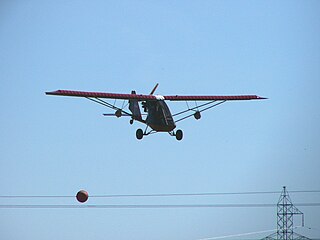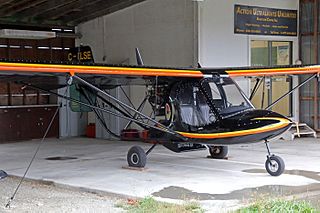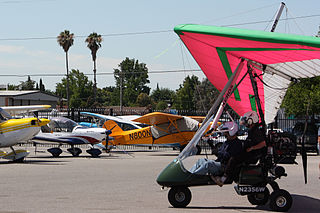
The Aero Adventure Aventura is a family of ultralight amphibians marketed as a kit aircraft by Aero Adventure of DeLand, Florida. The aircraft was designed by Bob Bailey in 1995.

The Birdman Chinook is a family of single and two-place, pusher configuration, high-wing ultralight aircraft that was first flown on 12 December 1982 and produced by Birdman Enterprises of Edmonton, Alberta, Canada, starting in 1983.

The Flightstar is a large family of single and two-seat, high wing, single engined kit aircraft that was produced by Flightstar Sportplanes of South Woodstock, Connecticut. In 2009 the rights, tooling and parts inventory were sold to Yuneec International of China when Flightstar Sportplanes' business was wound up.
The Freebird II is a family of American side-by-side two-seat, high wing, tricycle gear, pusher configuration single engined kit aircraft originally designed for construction by amateur builders by the Freebird Airplane Company of Marshville, North Carolina, and later Pro Sport Aviation of Wingate, North Carolina.

The CGS Hawk is a family of high wing, strut-braced, pusher configuration, single and two-seats-in-tandem ultralight aircraft, designed by Chuck Slusarczyk and manufactured by CGS Aviation.
The Excalibur is an American two seats-in-tandem, high wing, pusher configuration ultralight aircraft that is manufactured in kit form for amateur construction, by Excalibur Aircraft of Sebring, Florida. It was introduced in 1993.
The Capella Javelin is a family of American open cockpit, high wing, tractor configuration, conventional landing gear-equipped ultralight aircraft that were produced in kit form by Capella Aircraft of Austin, Texas and intended for amateur construction.

The Rans S-12 Airaile is a family of related American single-engined, pusher configuration, high-wing monoplanes designed by Randy Schlitter and manufactured by Rans Inc. The aircraft are available in kit form for amateur construction.
The RagWing RW22 Tiger Moth is a two-seats-in-tandem, biplane, conventional landing gear, single engine homebuilt aircraft designed by Roger Mann and sold as plans by RagWing Aircraft Designs for amateur construction.

The Flying K Sky Raider is a family of American, high wing, strut-braced, single engine, conventional landing gear ultralight aircraft that was designed by Ken Schrader and produced by Flying K Enterprises and later Sky Raider LLC of Caldwell, Idaho for amateur construction.

The Carlson Sparrow is a family of American, high wing, strut-braced, single engine, ultralight aircraft that was designed by Ernst W. Carlson and produced by Carlson Aircraft of East Palestine, Ohio and later Skyline Technologies of Salem, Ohio for amateur construction.

The Sport Flight Talon is a high-wing, pusher configuration single-engine, conventional landing gear homebuilt aircraft or ultralight aircraft, that was produced by Sport Flight Aviation of Sandy, Oregon in kit form for amateur construction.

The Earthstar Thunder Gull is a family of cantilever high-wing, tricycle gear ultralight aircraft, manufactured by Earthstar Aircraft of Santa Margarita, California as a kit for amateur construction or as a completed aircraft.

The Titan Tornado is large family of cantilever high-wing, pusher configuration, tricycle gear-equipped kit aircraft manufactured by Titan Aircraft of Austinburg, Ohio, for amateur construction.

The SlipStream Genesis is a family of American, strut-braced, high wing, pusher configuration, tricycle gear aircraft, produced in kit form, for amateur construction. Designed by Chuck Hamilton, the series were originally produced by Innovation Engineering of Davenport, Iowa and more recently by SlipStream International of Wautoma, Wisconsin.

The Raj Hamsa X-Air is an Indian, two-seat, high-wing, tricycle gear, tractor configuration, ultralight aircraft produced by Raj Hamsa Ultralights of Bangalore, Karnataka in kit form, for amateur construction.

The Antares MA-32 is the first model in a large family of Ukrainian ultralight trikes that is designed and produced by Antares Aircraft and at one time marketed by Leading Edge Air Foils as the LEAF Antares. The aircraft are supplied as kits for amateur construction.
The Fletcher Hercules is an American two-seat ultralight trike that was designed by AW Harrison and produced by Fletcher's Ultralights of Turlock, California, in the late 1990s and early 2000s. The aircraft was supplied as a kit for amateur construction and was also available as a completed aircraft.
The Solo Wings Aquilla is a South African ultralight trike designed and produced by Solo Wings of Gillitts, KwaZulu-Natal. The aircraft was also sold in the United States by Bateleur Sky Sports of Palm Coast, Florida in the early 2000s, under their own name.
The Harmening High Flyer is an American powered parachute that was designed and produced by Harmening's High Flyers of Genoa, Illinois.


















